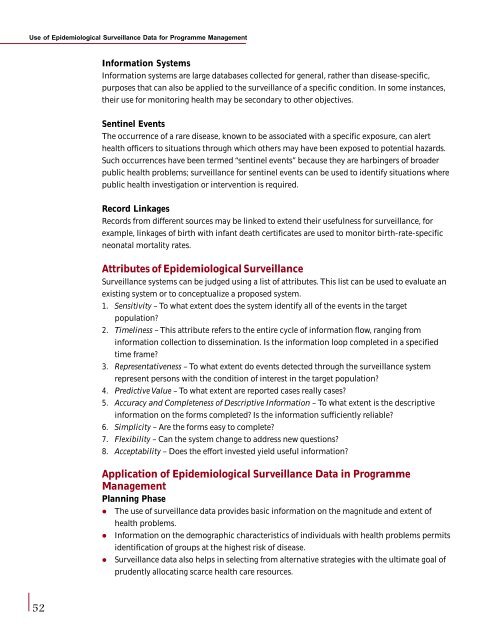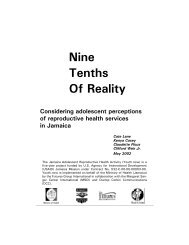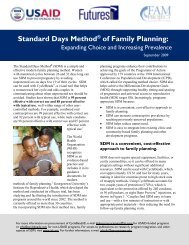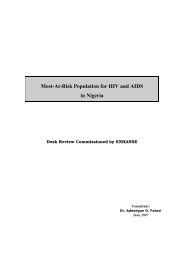Health Policy Issues and Health Programmes in ... - Amazon S3
Health Policy Issues and Health Programmes in ... - Amazon S3
Health Policy Issues and Health Programmes in ... - Amazon S3
- No tags were found...
Create successful ePaper yourself
Turn your PDF publications into a flip-book with our unique Google optimized e-Paper software.
Use of Epidemiological Surveillance Data for Programme ManagementInformation SystemsInformation systems are large databases collected for general, rather than disease-specific,purposes that can also be applied to the surveillance of a specific condition. In some <strong>in</strong>stances,their use for monitor<strong>in</strong>g health may be secondary to other objectives.Sent<strong>in</strong>el EventsThe occurrence of a rare disease, known to be associated with a specific exposure, can alerthealth officers to situations through which others may have been exposed to potential hazards.Such occurrences have been termed “sent<strong>in</strong>el events” because they are harb<strong>in</strong>gers of broaderpublic health problems; surveillance for sent<strong>in</strong>el events can be used to identify situations wherepublic health <strong>in</strong>vestigation or <strong>in</strong>tervention is required.Record L<strong>in</strong>kagesRecords from different sources may be l<strong>in</strong>ked to extend their usefulness for surveillance, forexample, l<strong>in</strong>kages of birth with <strong>in</strong>fant death certificates are used to monitor birth-rate-specificneonatal mortality rates.Attributes of Epidemiological SurveillanceSurveillance systems can be judged us<strong>in</strong>g a list of attributes. This list can be used to evaluate anexist<strong>in</strong>g system or to conceptualize a proposed system.1. Sensitivity – To what extent does the system identify all of the events <strong>in</strong> the targetpopulation?2. Timel<strong>in</strong>ess – This attribute refers to the entire cycle of <strong>in</strong>formation flow, rang<strong>in</strong>g from<strong>in</strong>formation collection to dissem<strong>in</strong>ation. Is the <strong>in</strong>formation loop completed <strong>in</strong> a specifiedtime frame?3. Representativeness – To what extent do events detected through the surveillance systemrepresent persons with the condition of <strong>in</strong>terest <strong>in</strong> the target population?4. Predictive Value – To what extent are reported cases really cases?5. Accuracy <strong>and</strong> Completeness of Descriptive Information – To what extent is the descriptive<strong>in</strong>formation on the forms completed? Is the <strong>in</strong>formation sufficiently reliable?6. Simplicity – Are the forms easy to complete?7. Flexibility – Can the system change to address new questions?8. Acceptability – Does the effort <strong>in</strong>vested yield useful <strong>in</strong>formation?Application of Epidemiological Surveillance Data <strong>in</strong> ProgrammeManagementPlann<strong>in</strong>g PhaselllThe use of surveillance data provides basic <strong>in</strong>formation on the magnitude <strong>and</strong> extent ofhealth problems.Information on the demographic characteristics of <strong>in</strong>dividuals with health problems permitsidentification of groups at the highest risk of disease.Surveillance data also helps <strong>in</strong> select<strong>in</strong>g from alternative strategies with the ultimate goal ofprudently allocat<strong>in</strong>g scarce health care resources.52







